Hattin’ Around Hat Cases are a solution to how to transport hats safely. I am honored to be part of the HATalk‘s Issue 135, in the Letters to the Editor.



Thank you HATalk.
Hattin’ Around Hat Cases are a solution to how to transport hats safely. I am honored to be part of the HATalk‘s Issue 135, in the Letters to the Editor.



Thank you HATalk.
Is Coolie a derogative term? According to Wikipedia and the Urban dictionary, it is. Why then, is it still used so freely to describe the common conical shaped hat most commonly associated with Asian slaves or Asian manual laborers? I blame Hollywood. The actual hat is a Vietnamese hat called a Non-la.

I go through hat phases, and I am currently looking at the conical hat. The dilemma arises with the fact that what I am calling a conical hat, is more commonly known as a Coolie. So, do I use a term that is considered derogative by some (Coolie), or do I use a term that is less known & understood (Conical), there by causing confusion (I am not referring to a Hennin which is also a conical hat) and reducing the effectiveness of my communication? Finally, do I use Non-la which is the accurate term but is rarely understood?
Language is a living entity. Words are invented, their meanings evolve as was evident in my post about the word Vulgar. Words come into fashion and then out. To have a large vocabulary is an asset allowing you to choose a word that communicates more precisely. In this case a hat shape, commonly referred to as a Coolie clearly brings an image of the Non-la to mind, is offensive to some people? Conical is too vague, a cone does not really capture the essence of the hat shape.

This may seem unconnected, but it is related. I was recently reading some older books. I love the little hard bound short story books. I love the texture of the cover, I enjoy the turning of paper pages, and the smell of an old book. I also enjoy hearing how they communicate with each other, especially between the generations and in courtship. Recently I was reading The Twins, a children’s book by L.E. Tiddeman. There isn’t a publish date, but L.E. Tiddeman died in 1937 and wrote between 1880-1931. In just one short paragraph on page 32, she used the terms, gay, cripple, and nigger. Although I found this shocking, there was no malice, it was purely descriptive.

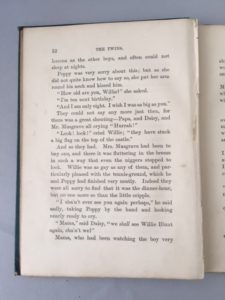
The terms cripple and nigger are no longer appropriate for common communication. New terms are used that are more sensitive and/or accurate. We have obviously made progress is this area. So, what do I call my Non-la hat? I would prefer to avoid the term Coolie, however I am not sure that very many people know the name Non-la. What would you call it? Would you stay with the commonly recognized term, like Coolie? A vague but inoffensive term like conical? Or, the actual name that is least known – the Non-la?
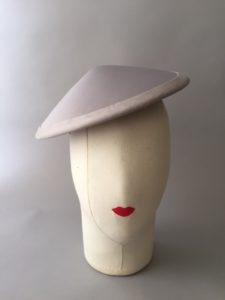
I recently made a new hat, which I am calling my ‘Non-la inspired conical hat’. Soon I will be adding a new post about making this hat.

I had a brilliant charity shop find of this conical asian hat, but I don’t think it is actually a Non-la. So what do I call it? Here is a link to my A Good Hat Day blog.
I have been wanting to go to The Hat Works Museum in Stockport for years. HATstock made it happen for me. However, I am going to need another day to go up and see the Museum properly.
 This was a high density day. Early train ride from London, new city and venue, 6 talks, each lasting 30 minutes, exhibits from milliners with varied styles and materials, a market place of lovely millinery supplies and a beautiful museum. Concluded with a quick search for a sandwich and a 3 hour journey back home. Only for hats or a sick child can I endure that dense and lengthy of a schedule.
This was a high density day. Early train ride from London, new city and venue, 6 talks, each lasting 30 minutes, exhibits from milliners with varied styles and materials, a market place of lovely millinery supplies and a beautiful museum. Concluded with a quick search for a sandwich and a 3 hour journey back home. Only for hats or a sick child can I endure that dense and lengthy of a schedule.
Presentations were informative and entertaining, which is a very good combination. Here is a highlight of the talks I attended.
Here is a trailer of the movie, but the whole movie is only available through a Parkin Fabrics presentation.
Nick also passed around various samples of sinamay materials. A very light weight and soft fabric used for making wedding garments for the very hot Philippine environment. Unlike the much stiffer sinamay we use for hats.

Then the tighter weave and panning of sinamay which makes what we call pinokpok which is also used for hats.
Sophie did a great write up of their talk and Hatstock. I can even prove I was there. This is me in the front row wearing a black cap with Harris Tweed trim and my Hat Case at my feet. If you want to read the whole Hatty Heaven blog article.

Here are a few links for The Hat Stand Sheffield and the specific millinery sites for Sophie Cooke’s Imogen’s Imagination, Siobhan Nicholson Millinery’s Etsy shop, and Amanda Moon Headwear.
Bink is as bubbly to talk with as she is in appearance. I have seen the Pearls and Swine brand in my social media sites, but I cannot tell which one: Twitter, Instagram or Facebook. With a name like Pearls and Swine I didn’t forget.
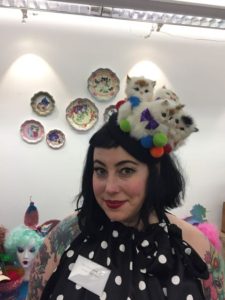
Her social media advice was great. Although a bit vague on specific actionable steps which I would have liked, her messages were powerful and clear.
Bink has marketing mojo in more than just social media. When I visited her millinery exhibit, she gave me a little goodie bag with her card, as well as cards of other people. She too is leveraging relationships with other vendors, less formal than The Hat Stand ladies, but still valuable. Look at all these little treasures in the pink and white striped goodie bag.

Bink has several lines of hats and headwear. Pearls and Swine and Temptress of Waikiki
Rupert told stories told through narration of old photographs that had been lost for generations in various family homes. The pictures had all the costume and glamour of a BBC period drama. Rupert’s sense of humor and story telling was amusing. It was riveting to see these very old pictures and hear stories. Some challenges, some victories, and the elegance of a wealthy family long ago.

Battersby Hats of Stockport, An Illustrated History, by Rupert Battersby.
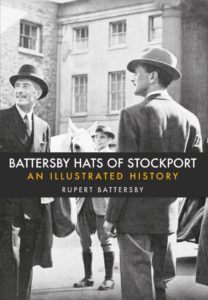
The Hat factory which has evolved over the years. The large water tower on the left was built after the hat works burnt twice. However once the water tower was built they never had a fire. I suppose the water tower indirectly did the job.

I’ve known Georgina and Becky, the founders of London Hat Week since the first London Hat Week several years ago. I always enjoy talking with them. They were at HATstock to promote the idea of building regional hat events. If the energy and excitement of HATstock is any indication, it is a great idea. Personally I would love to visit more regional events. Georgina Abbott owns Atelier Millinery and Becky Weaver is the editor of HATalk.
Here I am pictured with Bronwen (the coordinator of HATstock) on the left, Becky & Georgia in the center, and me to the right.

I loved Sharon’s presentation. It was a mix of slide show and commentary on hats and the creation of identity. How a hat can change your mood as well as your persona. She touched on the idea of a milliner as a technical crafts person and having the artistic vision to generate a transformation of the wearer.
Sharon is very knowledgeable about hats and history and her diverse career path is fascinating. From lawyer to milliner, to Leeds College of Art tutor to exhibit curator. I would like to spend more time with Sharon and attend more of her talks.
I love getting together with milliners. They are a diverse and interesting mix of people with marvelous stories and skills with a common interest in hats. I came home exhausted but my hatting cup was full.
Thank you all for a great day.
The Vulgar Exhibition, an exhibition that explored the term Vulgar hosted at the Barbican, a brutalist multi-arts and residential center in London. I wanted to see if the exhibit could reveal the magic line between ridiculous/inspiring and vulgar.

I can generally glean a nugget of knowledge, from everything I do and London has really good exhibits from Barbican, The Crime Museum Uncovered, with photos and displays of evidence and their strange stories to the V&A, Alexander McQueen show which I went to at least 5 times and found something new to look at each time, and the recent The Vulgar exhibit which explored the term Vulgar and how it has evolved and different interpretations of the term highlighted through fashion and literature.
Vulgar originated in Latin as Sermo Vulgaris meaning common speech as opposed to the more formal and social dialect of classic Latin. The use of vulgar meaning common has evolved into meaning a lack of good taste or explicit and offensive.
Sparkly Bra dresses range. This was exactly what I am talking about in this blog post! I love the first one, it is interesting, exciting and inspirational. The all black one is good also. The third pink I think is a bit ridiculous, and there is an element humor as she looks like she is wearing a crown. Finally the last one, I really do not like. I will need to reflect further these to see if I can figure it out. I would love to hear if you have any ideas you have on what makes the first won great and the last one not. Or perhaps you think differently, I’d love to hear that also.
Rudi Gernreich’s 1960’s Topless swimsuit was so shocking it had to be displayed for exhibit on a wall rather than a mannequin. I don’t actually find it offensive, but I am sure there are some who do.
I fear being seen as lacking in good taste, but I refuse to be restricted to conservative tailored clothing. I must have a bit of an edge to be truly content. However when it comes to designing I often get caught in the trap of wearable, sell-able, and tasteful which can be very limiting.
I had hoped the exhibit would explain/reveal that secret zone that is edgy, exciting and breathtaking without falling over into vulgar. Yes that was a bit much to ask of an hour in an exhibit. To explore the exhibit more take a look at New York Times. However I have a sense that I am closer to my goal, and that it isn’t about a mysterious zone that is agreed upon by everyone but a place within myself which I must explore and ultimately trust.
Now I need to figure out how to banish the fear and the voices, internal and external that judge.
Exploring the fear
I fear the place of mis-aligned, drawn-on eyebrows, crocheted tissue box covers, cheap plastic anything, and ugly sparkly sweaters. Imagine my surprise that here in England there is a deliberate ugly Christmas Jumper tradition.
Exploring the voices that bring fear and doubt. The voices that I recall from my youth that would say, “look at that outfit” with the tone of admiration verses the same phrase with the tone of disgust. How to banish the voices that confine me?
My own experience of revulsion at design and craftsmanship. The earliest I can recall was at the Twin Sisters boutique in San Jose, California. My grandma’s neighbor and her sister created this business venture which was really just a garage sale.
I love flea markets and garage (boot) sales. Amazing treasures can be found for just a bit of money, allowance money when I was a child. So when I was young, while visiting Grammie on a weekend, she said, girls (me and my sister) lets go down to the sale. I had a bit of money to spend, perhaps Grammie gave me a couple of coins, I don’t recall. I was excited with the prospect of a new treasure and supporting Grammie’s friend in her new business.

It was awful and I was disappointed. The things she and her sister had made were the most poorly made things I’d ever seen. I truly believed I could do better. Now granted my Mother is a master seamstress, with a good eye for colour and has taught sewing, so perhaps my standards were higher than your average girl of about 7 years old. Grammie insisted that I get something, but there was nothing I felt was worth my few coins. Finally, Grammie gave me an understanding glance and said, “just pick something”, so I chose a tacky lopsided pot holder with crooked stitching and fraying seams.
I fear having someone look at what I make with the horror and revulsion. Intellectually I know this is highly unlikely, but it is a non-rational fear.
A Friend who makes Monsters
Tamara is the most organized person I have ever met, in what appears to be every part of her life. She manages the household accounts with a masterful use of spreadsheets. She hosts parties where she makes beautiful food and is dressed before the first guest arrived. She works at either a job or her own business, is a mother, wife and considerate daughter. Her personal dress is conservative and classic. And if that isn’t enough she has a hidden side, she makes monsters. The most amazing creative creatures. Usually with sharp teeth or long claws, but they contain a magical balance of whimsy and ugly to equal amazing.
Somewhere in craftsmanship and design is a magical place of beauty. Tamara’s monsters were inherently ugly but in such a sweet way and the attention to detail of each one is superb. Where as even simple square-ish pot holders from Grammie’s neighbor were vulgar.
The Vulgar was an interesting exhibit but it ultimately failed to reveal the secret sweet spot of where the brilliance of creativity and design tips over the top and slides under the bar, into tacky and repulsive. I think there is an element of superb craftsmanship that moves the bar. If the exhibit was still on, I would go again but more slowly the second time.
Hats Included
A bit more about hats and head pieces at The Vulgar exhibit. There were some divine Viennese bonnets from the Wien museum dated 1780-1810. I didn’t find any photos or links.
There was a reference to Sally Victor’s Mondrian style hat which to my delight I saw at the High Style exhibit and the Legion of Honor in San Francisco, May 2015. The Vulgar explored the ideas of imitation. I gathered a few images together featuring the Mondrian style.
Imitation vs. Inspiration
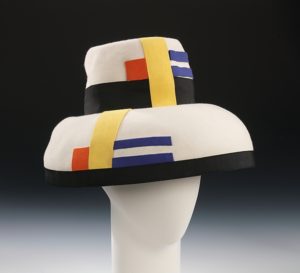


In addition, at The Vulgar there were hats from Philip Treacy, Stephen Jones and a couple more, which I should have written down. Hats were not the focus, they rarely are in exhibits, but I was pleased they at least were given some attention.
The quest in finding my artistic voice continues. I would love to hear about your quest to find your artistic voice.
I was lucky to have a chance to study with Marie O’Regan, a couple of times this January and I hope to do more. There are some who have been studying with her for 10 years. She has taught many of London’s best milliners. You can hear Edwina Ibbotson, mention her in a previous podcast/post, Their Journey into Millinerys with Edwina, Rachel and Noel. She also taught Ian Bennet, who I took a feather class from a couple years past. The list goes on and on.
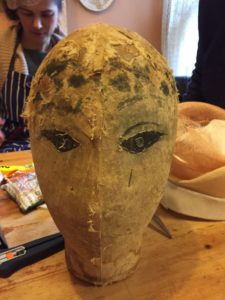
This is one of Marie O’Regan’s poupeès and I love it. I can feel the years and the people whose lives have been touched by Marie, her hats and her teaching. If you just see an old tattered head, you are not a milliner yet.
Marie will be 92 this year and has been doing Millinery since she was 14. She is from France and retains a lovely French accent but has been in the UK for decades. She has been milliner to the Queen, taught at the London College of Fashion and instrumental in starting the Worshipful Company of Feltmakers annual hatmaking contest. There could be books written and movies made about her, but that is beyond the scope of this little blog post. I will focus on the things I worked on, with her tutelage.
The day starts with coffee and biscuits while the students discuss with Marie what they plan to be working on. We move to a work table, and Marie moves around making sure everyone has what they need and can begin working. She will take her place at the head of the table, often with a poupeè between her knees to show placement, technique and design.

I have learned that with these types of work/study classes, it is best to come with a couple different ideas and materials. However, I believe the key to a successful day and getting the most you can out of it, is to relax into the flow and see what amazing nuggets of knowledge the tutor will offer in the process of doing some millinery project.
On day one, I brought 3 different hats with questions about head fittings. However as I went through each piece with Marie, she would ask what else I brought. Until I selected the last piece, a blocked orange cloche. That captured Marie’s attention and the focus became the trimming of the cloche. I had blocked it months ago with vision of a layered ribbon trim. I’d made several trips to V.V.Rouleaux a lovely ribbon shop in London which has a glorious selection of ribbons including Petersham. I ended up with some striped grosgrain ribbon to coordinate with the petersham ribbon from Parkin Fabrics that matched the felt.
To my distress, I was instructed to put slashes along the sides and an angle. It was emotionally difficult to cut into the body of the felt, as that was not at all what I had in mind, but again. I reminded myself that it is only a felt and a bit of blocking time, I followed Marie’s lead to see where it would go.
I tried curving petersham and placing it in various layouts on the hat. I learned that if you are going to weave in and out you need to have an even number of slits otherwise it doesn’t end correctly. I don’t know why I always forget to take a picture of how it looks on the first try until I’ve finished taking it apart.
I learned that it is technically difficult to keep the slits a the right angle and distance when the hat itself is changing shape from front to back. Marie could sense that I was struggling and that I needed to let that project simmer a bit to decide what I wanted to do next.
At, midday the dining table is set and she served a lovely lunch which included a glass of bubbly. The French know how to serve a lunch.
In the afternoon, I was gifted with an opportunity to see Marie work with an egg iron to shape buckram into a new hat block. Marie is not only a remarkable milliner and teacher but also a sculptor.
I watched her look at an original shape and then a piece of flat buckram, then with a sure hand she lightly moistened the buckram with a damp piece of calico, then pulled the buckram over an astoundingly hot egg iron, see photo at the end of iron in the fire. The egg iron was covered briefly with another piece of damp calico, to generate steam and protect the buckram. The calico was frequently wisked from hot egg iron and moved to a new damp spot.
A second piece of buckram was added to fill out the shape and then a wicked hot small metal iron and a pressing pad, was used to fuse the two pieces together at the join.
The second day started with me trying to explain and idea about a removable brim for a hat, but that idea did not gain much traction. Marie had a different idea, she offered me an unusual twisted buckram shape which she wanted me to shape myself, using the technique she taught in the previous class, with the egg iron and the little flat iron. There is still much work to be done to make either of the two shapes useful, but the experience was very rewarding.
Here I am wearing Marie’s block that she pinned into shape, so that I could see the balance when it is put together. I love the creativity of the shape and if it looks this good in spartarie and a knit stocking, just think what it can be in a bright coloured sinamay or felt.
One of the things I like best about millinery is that the techniques of 100 years ago, still work. Flat iron, egg iron, kettle and some fire along with a bit of calico, water, pins and pressing pads, with a few basics the millinery opportunities are endless.
To wrap up, it was a total thrill to see Marie manipulate the buckram with such simple tools and immense skill. Unfortunetly, I have two new partially made shapes now to add to the massive unfinished projects list. I hope to return for more classes.

London Hat Week 2016 (LHW2016) was a success! My workshops were well attended with good reviews. I packed in as many event as possible and loved the variety. Everything from the Hat Walk with Laird Hatters, Champagne High Tea at the Villandry, The Hilary Alexander and Stephen Jones interview at the Dirty Martini, Hat Exhibition at Coventry University in London and movie night at The Cinema Museum to watch the documentary, Mad about Hats. Here is my summary of the week. Note: the following video sometimes loads slowly.
London Hat Walk and Interviews from Phase 7 on Vimeo.


Hat Walk with year was a little different than the last couple and I’d say very successful. Laird Hatters sponsored the event and we were treated to a spot of tea and cake at The Espresso Room to start our journey at their New Row shop and a reward for finishing at their shop on The Strand with a lovely chocolate and a little tipple. The walk route was good fun featuring a leisurely stroll to Trafalgar square, where we stopped to take photos, chat and regroup, then continued on to the end point. I met several fabulous women from the Red Hat Bees of Bardwell, a woman from Scotland, as well as the Netherlands and Spain.


There was also an Interview of Georgina Abbott and Becky Weaver, Founders of London Hat Week.

The Stephen Jones interview by Hilary Alexander was absolutely charming. The two had a lovely chemistry that comes from years of working in the fashion industry where they were familiar with the same people over many decades. The venue, Dirty Martini was fun and interesting but ill suited for this event. Many of he attendees I have met over the years. It felt like a fun reunion.

The Market Place venue had amazing murals and architecture, but I stayed focused and true to my mission to explore the millinery supplies. 😉 I alway love a chat with Catherine and Owen of Guy Morse Brown.

I bought a few bits from Masario and some felts and Petersham from Parkins.


I am looking forward to heading over the East London to visit the ladies at Walter Reginald, leather specialist. They were fantastically helpful and educational. Who knew there is Ostrich leg leather. I am also wanting to try out fish leather. I touched it for the first time, and was surprised at how “leathery” it felt.
Hattin’ Around Classes and Milliner’s Roundtable at London Hat Week 2016
@Mrs_Gaskett picture on instagram of nautilus she made in class.
A Study of Peaks workshop covered a lot of tips and techniques on materials and shapes.
Milliners Ribbon – Petersham workshop, learning about basic things, how to make a head fitting and shrinkage to advanced trimmings such as Cockades and the Nautilus. I also demonstrated how to do some vintage trimming from hats in the V&A Museum of Childhood collection.


The students were a delight. I had people from all over the world with varying levels of interest from ladies who have been in the millinery business for 20 years, to others who enjoy it as a hobby. I received great reviews and everyone said they learned something new.
A big huge thank you to Baxter Hart and Abraham for their generosity of ribbon and information about Petersham. Go see them for supplies, they are in Luton and have always been wonderful to me. The best part is they are patient with new milliners.
Milliner’s Roundtable


There were lots of good tips from the Milliner’s Roundtable. A mix of milliners from Australia, France and a strong showing from the UK crowd. Several ladies from the South London as well as two who are near the same village in southern England, who knew of each other but had never met. Here are some ideas to help build awareness and a following that I really appreciated:
Champagne High Tea at the Villandry was fun, but perhaps a poor choice of events to attend, as I had cut out refined sugar and alcohol from my diet. I have been to better venues for High Tea in London, but I always like trying some place new. The best part was getting to chat with charming people from the UK and Europe. We even swapped photos of hats we liked at the exhibition.
Movie Night at The Cinema Museum, the Museum is in the Victorian magnificence of the old Lambeth Workhouse, where Charlie Chaplin spent time as a child, in Kennington. It isn’t the easiest of places to find but it is a treasure. I joined other milliners to see an informative and interesting movie about the making of fur felt, the plight of the beaver and the impact of mercury used in hat making. Mad about Hats was a labour of love for director Olivier Vandersleyen and his family. Here is the Mad about Hats trailer.
I am seated in the grey fedora, next to the sign. The director and his wife are standing behind the sign, hatless.
Hat Exhibition at Coventry University, London was a sight to behold. Hats from around the world in many ways. I posted several pictures on my Facebook page.
So much of millinery and hatting is done in isolation, at least for me. Late evenings or while my children are at school. London Hat Week is an opportunity to connect with people of similar interest from all over the world. Thank you Becky Weaver of HATalk and Georgina Abbott of Atelier Millinery for creating this wonderful event. I look forward to more at the next London Hat Week is planned for Spring 2018, dates TBD.

Edwina Ibbotson, Rachel Trevor Morgan and Noel Stewart share their journey into millinery. This is part 1 of a series of podcasts from Milliner’s Question Time at London Hat Week 2015.
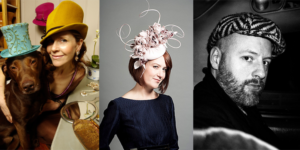

For one milliner it was a direct path for another there were many turns along the way. Listen to Noel Stewart, Rachel Trevor-Morgan and Edwina Ibbotson talk about their journey’s into Millinery.
This interview I moderated was recorded live before an audience at McLaren Hall during London Hat Week 2015. I will be releasing the recordings in several 20 minute podcasts. Please sign up for the Hattin’ Around Newsletter to find out when the next episode of Milliner’s Question Time 2015 interview has been posted.
Show notes are below.


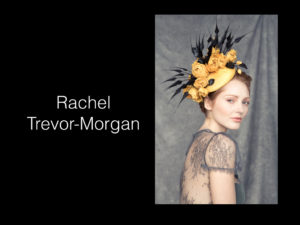
Please enjoy getting to know three amazing people and clever London Milliners.
Show Notes:
London Hat Week 2015
Milliners’ Question Time
MacLaren Hall 11-13 Mandeville Place, London
Show Timing:
00:20 Intro
01:20 My introduction of Edwina, Noel & Rachel
01:47 Edwina Ibbotson’s Introduction
02:47 Noel Stewart’s Introduction
03:25 Rachel Trevor Morgan’s Introduction
04:12 Leanne askes about their journey into millinery with Roses & Thorns.
05:16 Noel Stewart shares his journey in millinery.
08:26 Rachel Trevor Morgan shares her journey.
12:23 Edwina Ibbotson shares her journey.
21:06 Conclusion & Thank you’s

Edwina Ibbotson’s Introduction
Milliner for over 20 years
Studied at Fashion Institute of Technology NY with Ann Albrizio
London College of Fashion with Marie O’Regan
Studied with Rose Cory and French milliner Roland Bouget
Work for top London milliner, Philip Somerville
Pieces called for exhibits and photo shoots
Edwina’s designs are couture millinery at its best. Her designs are flirtatious, timeless, romantic with a slight vintage feel and constructed to perfection.

Noel Stewart’s Introduction
Studied at the Royal College of Art
Worked for Designer Dai Rees
Stephen Jones’ assistant at Christian Dior, John Galliano, and Louis Vuitton
Appointed Creative Director at Christy’s & Co. Hats, owned by Liberty
Noel’s inspiration comes from contemporary art and architecture. Whilst using his extensive skills, he modernizes millinery.

Rachel Trevor Morgan’s Introduction
Milliner for 25 years
Operates from her 17th century atelier in St. James’
She is a Liveryman of The Worshipful Company of Feltmakers
Granted the Royal Warrant of appointment to Her Majesty the Queen
Has a husband and three children.
Rachel is renowned for her beautiful handwork and design. Resulting in a glamorous feminine elegance.
Noel Stewart’s Journey
Lampshade project
Evening course summer holiday
Favorite task is stitching a Petersham
Making furniture – making hats
Dai Rees – steep learning curve
Stephen Jones
Royal College – Millinery MA
Philip Somerville
Stephen Jones
Rose/Thorn – Everyday is different
Rachel Trevor Morgan’s Journey
Traditional foray into millinery
A levels – started focus on the theater
Mother wore a lot of hats to church on Sunday
Wrote to 10 hat companies in West 1 (London), must be good.
Kangol – Graham Smith – met Graham, offerred a job. Best place to learn for 3 years
Philip Somerville – smaller business – met Edwina (Ibbotson) Learned the other side of business
Market stall – Central St. Martins
Little workroom that was rent free
Moved to St. James been there for about 22 years
Rose – adore her job – Thorn – long hours
Love & Hate in equal measure
Don’t go home for 3 weeks before ascot
Edwina Ibbotson’s Journey
Photography in Edinburgh
Ice cream parlor – hated it
Rework hats from charity
Nanny in American for a few months
New York – FIT 9 months
Ann Abrizio tutor –
Met Lilly Daché and Mr. John – didn’t fully appreciate it
Course should take 3 yrs, but did it faster
Following boyfriend to Nottingham, decided can’t live here
Had been to Leeds, Manchester, London
Lived in squats
London College of Fashion
Stephen Jones interview, but no job
Marie got her a job at Philip Somerville’s – Mr. Somerville
Marie teaching Carole Denford (The Hat Magazine) there at the same time.
Lunch meet friends and not go back
Class w/ Rose Cory
Class w/ Roland – she lived in Paris
Rachel was very sweet and would let Roland, Edwina, and Andrew use her workroom for a few months.
House model at Philip Somerville’s – holes in jeans, Dr. Martens, hair a mess. “Get Edwina a nice dress”. Occasionally answer the phone. Small workroom, on a busy day had 8 milliners. Older ladies w/ lots of experience
Work experience in Paris – Knocked on Marie Mercie’s door. They glued everything – not impressed but they did good work on the 17 guinea machine.
Princes Business trust, loan & grant
£40 government scheme
Living in squats – amazing houses
Climb through the window
Two different lives – ladies who could afford expensive hats.
Clerkenwell Green
Bridal wear designer
Fashion lady
Same shop for 18 years
Doesn’t sell to trade anymore, mostly private clients
Love going to work everyday
Thorn – ratio of home life & work life.
Thank you to Noel Stewart, Rachel Trevor Morgan and Edwina Ibbotson as well as Becky Weaver from HATalk, Georgina Abbott from Atelier Millinery, and Owen Morse Brown of Guy Morse Brown for their help in coordinating the venue, ticket sales, and audio recording.
I love the charity shop hunt. I don’t know if it is the biological hunter/gatherer instinct or a conditioned response from flea markets and garage sales with my father as a girl, but Monday I hunted and gathered.

This particular Monday brought me to Tooting, London. A name that always brings a smile to this California born girl. There was a charity shop across the street and I had a few minutes before I’d be missed, so I tucked into the shop. It was a gold mine for me. I rarely find hat books at Charity shops, but this was a good day. I discovered a fun book on felting and making hats, Fabulous Felt Hats by Chad Alice Hagen another was a child’s book The Hairy Hat Man’s House by the Letterland Storybooks and just as I was about to leave, high up in the window display was a wonderful conical straw hat. I’ve been on a bit of a Conical (aka Coolie) shaped hat kick lately. My computer desktop is full of images and my pinterest Hats pinboard is all about conicals right now.

A hat and two books later, I return home to discover that the latest edition of The Hat Magazine has arrived! The first thing that must be done is to flip to the back for the Workroom Technique section. This issue is, “How to Work with Feathers” by Edwina Ibbotson and it did not disappoint.

In addition to the Monday, Good Hat Day, I’ve had two “finds” and book shops lately. My eldest daughter is a book junkie. She can’t pass a book shop without wanting to go in. And seeing as I am like that with fabric and hat shops, I can’t fault her. So I end up in a lot more book shops that I would on my own. Over the previous week I discovered two books, The Panama Hat Trail by Tom Miller at Travelling Through and Hats by Colin McDowell at Skoob Books. In true Leanne-form, I have started all of them, but the only one I’ve properly read all the way through is….yes, the children’s book. I am a slow reader, so this back log of books should keep me busy for the remainder of the year and into the next.
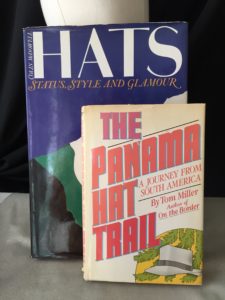
Back to the “Good Hat Day”, I then went into work, where I work on the computer doing the marketing, social media, website updates, invoicing, and anything else that needs to be done, while surrounded by beautiful hats and intensely creative skilled people. And to top it all off, hat class, where I could work on my own Conical shaped hat. Three layers of sinamay and I’ve wired the edge so far.

AND THAT is a Good Hat Day to me! Have you had a good hat day? Tell me about it in the comments, and sign up for my mailing list.

A long weekend trip to Amsterdam with my family and a quest to visit their local hat shops. I found an artist collective, two great hat shops, a nice fabric & haberdashery, and a funny hat lamp.
Artwear Jordan – Brouwersgracht 145
An artist collective with a focus on women’s fashion, beautiful linen garments, felted hats and jewelry. The founder is a woman from Marin, California. I find American expats all over the place. She was charming and I could have happily worn any of the pieces in her shop.



De Hoed Van Tijn – Nieuwe Hoogstraat 15
A tall gentleman greeted me and graciously answered my questions and allowed photographs. This shop is a mix of hats, not only mens’s and women’s styles but also covering many price points. There are some nice factory hats as well as couture pieces. He told me that his husband designs some of their hats, along with several other milliners. They were arranged by color rather than by designer collections which made for great pictures.



A. Boeken – Fabric & Haberdashery – 31-35 Nieuwe Hoog Straat, Centrum
A respectable fabric store with a vast assortment of fabrics. They take up about three shop fronts, each one unique, with a focus on different things. There was also a lovely yarn shop next door, called Stephen and Penelope Fine Yarn. As you can see in the picture, I was not the only one who was distracted by these shops while walking by.

Oh, good heavens! There is nothing like encountering a “Body Power” naked bike ride while walking over to the last hat shop. I hope you appreciate my careful picture selection of the cyclists from a rear view, having gone past us.

Hoeden M/V – Herengracht 422
A beautiful hat stop and a charming young woman, Bronte, who was gracious and welcoming, to my rather bedraggled family. The shop was really nice with several enchanting displays and variety of hat styles for men and women. They sell pieces from multiple milliners and also have their own brand, called Bronte which is designed by the young woman’s mother. They have shops in Dusseldorf & London. I haven’t been to the London shop yet, but I will go, soon.



On a different topic, I love apple pie. In fact I am a bit of an apple pie snob. It needs to be made with fresh tart apples. Overly sweet, mushy canned apple are extremely disappointing. I have had some amazing apple pies as my Grandma made fabulous apple pie for Thanksgiving every year in California. In California, when ordering an apple pie, you would often have a choice of Apple Pie or Dutch Apple Pie. It wasn’t until I was putting my fork into a glorious big slice of apple pie at Winkles in Amsterdam, that the little a-ha moment happened and I thought, “This is real Dutch Apple pie.” Here is a picture, as you can see, it does not have a crumble topping. I wonder if it is another example of the word Dutch, being confused for Deutsche, the word for German.

Amsterdam is made of many canals. Brewers canal was gorgeous and our AirBnB place as very small, perfectly eccentric and right on the canal. It was very picturesque.

I love second hand shops and we came across a large one – Episode. It had lots of hats. Actually they had lots of all kinds of clothing and accessories. I escaped without buying anything this time.
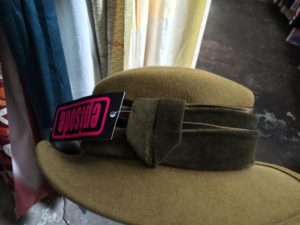
Perhaps the most unusual hat item of the trip was a red hat lamp in a store on the square in Harlemmerbuurt.
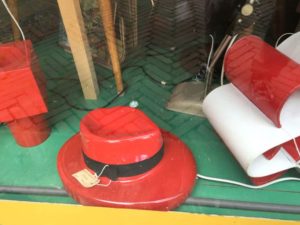
I dramatically under estimated the bicycle culture of Amsterdam. If I had not taken the picture myself I would think it was a commercial for how civilized a cycle culture can be. This is at the back of the train station by the ferries.

I am curious as to how they manage the derelict bicycles. Our small block of flats here in London constantly struggles with too few racks to lock our bikes as there are old rusty bike that remain locked to the rack, long after their useful life and likely the owners have moved out of the building long ago.
I possibly should have called my blog Hattin’ & Bikin’ around as I love riding my bike. In Amsterdam it is not just a commuting method it is a way of life. These are not what some Londoners call the Lycra brigade, the cyclists in their road racing kit that do battle with London traffic every morning and evening. In Amsterdam, people take their kids to school, pick up the days shopping and go visiting friends, using their bikes. Take a look at a few of the cycle parking lots that were particularly impressive. The first was a triple layer structure outside the central station, little did I realize there was another one on the other side by the ferries.

How about the cycle parking near a concert venue!

Amsterdam was a complete delight with many unique features. It was not the legal prostitution nor the pervasive aroma of canibis smoke that was the most stimulating for me, it was the bikes, and the fabulous hat shops. If you get the chance, it is a lovely place to spend a long weekend.
and remember, Interesting people wear hats.
Feather Dyeing, Cutting and making a Feather Mount. The thing with these classes are that in many cases I have the general idea of how to do these things, but it is the little tips and tricks of people who are experts that you pick up by taking a class or working with them in person that makes a huge difference. It is also great to learn different techniques. So learning how to dye and cut feathers from two different expert milliners is not a waste of time, in my opinion.

I took a great three evening feather cutting, dyeing and feather mounting class at Kensington and Chelsea College, here in London with milliner Ian Bennett. Ian gave out some lovely pages of notes that included his sketches, which were very helpful. I must admit to sketch envy. I would love to sketch well. You can get a glimpse of an Ian sketch in the corner of the image above from the results of my in-class dyeing.
Acid dyes are best for protein based fibers such as silk, wool and feathers. I experimented using some Jacquard dye I had from a previous silk dyeing project. The dyes were already in liquid form and I diluted them more, so my colours were not as bright as some, however I did like the softness of the muted colours.
I got a tripped up with the 24 hour time the night of my first class. I saw 18:30 on my calendar, and later remembered 8:30, rather than 6:30. I was embarrassingly late. I got the notes, but it just is not the same as being there. Ugh!
A few highlights
Sharp, long blade scissors, lightly pinch the spine, support the blade.

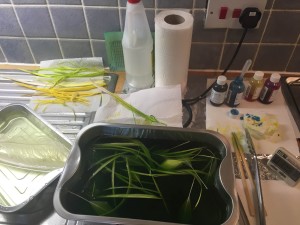
Nugget 1 – The ability to dye feathers (and other stuff) is one of the key elements to making unique one of a kind hat or head piece. Being unique helps enable you to charge couture prices for your creations.
Here is my dyeing station at home, aka the kitchen counter. I started with yellow, added a little blue, then added a lot of blue.
Do not boil the feathers, actively dry feathers, especially ostrich so the will return to being fluffy and not look bedraggled.
Nugget 2 – Feathers have personalities. This may seem obvious, but I grasped it on a different level after this class. You can trim them and change their appearance, but consider the “feeling” you want when making a feather mount. Some feathers are spiky like Biots and others have a “sharpness” like Turkey feathers. On the softer side, with a swaying movement are Coque feathers while a full ostrich feather offers a soft roundness. What about eye catching drama from Lady Amherst and Peacock feathers? Use them to create a tone and establish balance.

A feather mount is a collection of feathers that are combined onto a wire, so they can be placed on your hat as a single unit. Mine feather mount included goose, biot, hackle and a little bit of ostrich.
Nugget 3 – When making a hat, if you handle it too much it can look tired before you are even finished. By creating feather mounts you can conserve the amount of manipulation you need to do to the hat.
I have put my dyed feathers to use for my daughters school play. I am making 6 head pieces (aka fascinators) for the girls.

